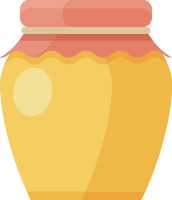What Makes our Honey Taste So Special?
Added by Kent Pegorsch on
Besides being so careful in how we handle our honey, one reason our honey tastes so good may be beyond our control. Terroir or "the taste of the place" is one reason Waupaca is the only place this special honey is available.
Terroir (ter-wahr; French): the conditions in which a food is grown or produced and that give the food its unique characteristics:
Terroir is commonly used to describe the environmental conditions, especially soil and climate, in which grapes are grown and that give a wine its unique flavor and aroma.

The same can be applied to honey yet honey is a bit more complicated. Honey is not a plant part nor is honey made by plants. Honeybees make honey by collecting nectar from plants. Nectar is 80% water and 20% sugars and micro nutrients.
The blossoms create nectar to attract bees to pollinate the flowers. When the honeybees collect the nectar, they "accidentally" move the pollen from the anthers to the ovules of the flower pollinating the flower in the process. Honey bees also collect pollen. Pollen is the main protein source for a honeybee colony.
During the process of bringing the nectar back to the colony and storing it in the honeycomb, bees add important enzymes to the nectar. These enzymes break down the complex sugars in the nectar, disaccharides, into simpler sugars called monosaccharides. This process is called inversion.

Inside the colony, the bees reduce the water content of nectar from 80% to less than 18%. They do this ny fanning air through the hive and over the cells of nectar.
Getting back to terroir, honey is a much more complicated food than wine. It is the result of the climate. the soil, many floral sources and the work of the honeybee.
As with grapes, the nutrients in the soils of a particular region affect the nectars produced by the plants. Monofloral honey from Basswood trees can taste much different region to region.
Probably the biggest influence on flavor is the variety of floral sources that are available in an area. In the Waupaca area we are blessed with a wide variety of flowers. The honey season that ranges from late May through late July in Waupaca has a variety of flowers that differ year-to-year in how much nectar they produce.

These floral sources include Black Locust trees, Dutch Clover, Yellow and White Sweet Clover, Basswood trees and Spotted Knapweed among many other minor nectar sources.
Each year the blend of nectars is slightly different but the results are very unique to the Waupaca area. This is one of the reasons we don't supplement our crop by buying honey from other beekeepers outside our area. We do offer Orange Blossom and Buckwheat honey from trusted beekeeper friends but we never buy honey and label it as our own. If our Waupaca honey sells out, we wait for the next season.

The next time you taste our honey, think of the taste as a moment in time, the taste of a place, sunshine and flowers captured in a bottle - by a honeybee!



